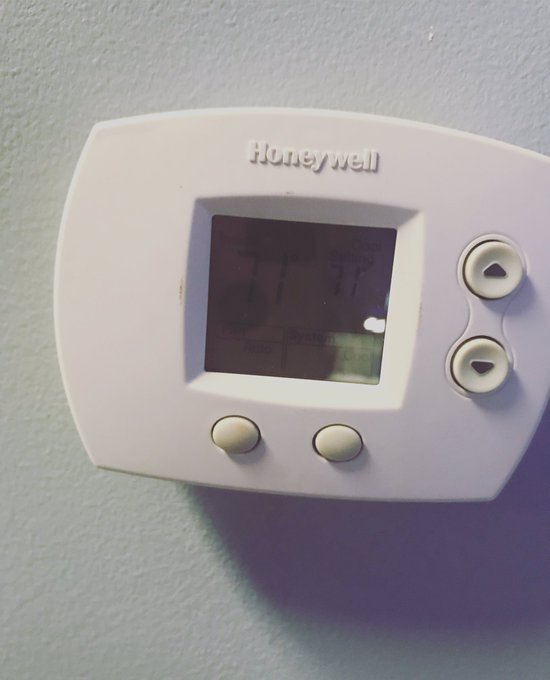By Amanda Schmidt, AccuWeather staff writer
The coolest temperature Americans should keep their thermostats set to is 78 degrees Fahrenheit, according to Energy Star, a federal program aimed at energy efficiency and cost savings for consumers. But many on social media do not agree with that recommendation.
And social media users were even more vocal in objecting to Energy Star's recommendation for nighttime thermostat settings.
During the summer months, especially during extended heat waves, energy bills tend to shoot up as users crank up their air conditioning. To combat this spike, Consumer Reports released some settings recommendations for air conditioners to help cut down energy usage and cost.
While some users may try to skimp on AC to keep the costs down, the report highlights the other ways to reduce costs.

Kimberly Henderson takes a quick look at her furnace thermostat in the front room of her rented home in Bangor, Maine, Tuesday, Jan. 29, 2008. (AP Photo/Michael C. York)
Energy Star, a joint federal program run by the Department of Energy (DOE) and the Environmental Protection Agency (EPA), recommends that for optimal cooling and energy efficiency, the coolest temperature consumers should keep home thermostats set to is 78 F -- and that’s only when they're at home and awake.
When consumers are out of the home, Energy Star recommends to keep thermostats set at 85 F and suggests 82 F as the optimal temperature for sleeping.
When WTSP investigative reporter Jennifer Titus shared this information on Twitter, a torrent of social media users expressed their disagreement with these guidelines. As of this writing, Titus' tweet had drawn a staggering 16,000 responses and counting.
Many users were quick to point out how challenging it may be to sleep with the room temperature 82 F -- and their points are supported by numerous studies. Temperatures that are too hot or too cold can negatively impact sleep patterns.
According to sleep experts, the suggested bedroom temperature should be between 60 and 67 F for optimal sleep. Temperatures should be slightly higher for toddlers: between 65 and 70 degrees Fahrenheit will suffice.
"How many bath sheets do you need to own if you keep the temp at 82 degrees while you sleep ... ?" one user tweeted in response.
Another social media user expressed concern for leaving her dog home with the thermostat at 85 F because of the risk for heat stroke. Dogs, like humans, are sensitive to changes in temperatures, but the best temperature for dogs depend on various factors, such as its size.
According to the American Kennel Club, most dogs begin to show signs of overheating when the air temperature is between 81 and 85 F. When determining the best temperature for their living space, people should consider a temperature that also works for pets .
Each person also has different tolerance to hot and cold temperatures, with certain factors like weight and age making certain people more susceptible for heat-related illnesses, according to the Mayo Clinic.
Heatstroke, the most serious heat-related illness, is a condition caused by the body overheating, usually as a result of prolonged exposure to or physical exertion in high temperatures. It can occur if the body temperature rises to 104 F or higher, according to WebMD. The risk of heat-related illness dramatically increases when the heat index climbs to 90 F or more.
Titus' tweet highlighting the temperature guidelines brought people of all backgrounds together, many of whom completely dismissed the federal recommendations.
"I don’t think they’ve been anywhere in the south," one user wrote.
"Jennifer; You provided the nation a much needed laugh, thank you. I particularly enjoyed how the humor escalated into the sleep time temp. Hysterical!," former FBI assistant director Frank Figliuzzi said on Twitter.
The best settings for the central air conditioning depends on whether a consumer's priorities are more about keeping cool or keeping a utility bill in check. Consumer Reports provides guidelines for finding a happy medium.
According to the DOE, energy customers can save about 3 percent on utility bills for every degree they raise the set temperature for a central air conditions system.
The report adds that those who are more heat-tolerant can experiment with the temperature, raising it 1 degree at a time to see how it affects their comfort and budget. And those who are not comfortable at 78 F can lower the temperature a degree at a time and let the system reach the new setting before ratcheting it down further.
The report suggests some other ways to bring the temperature in homes down, such as turning on a fan.
"If you live in an area with moderate temperatures, you might not need your central air conditioning all day and night. Take advantage of cooler night temperatures by keeping your windows open. Close them first thing in the morning and keep your shades and curtains drawn when it’s sunny outside to prevent the sun from heating up the house," the report reads.
The report also says that if a consumer needs the AC when returning home, the consumer can program it to go on before arriving or by altering it with their smartphone.
Avoid using a washer, dryer and dishwasher during the heat of the day, the report says. Use the exhaust fans in the kitchen when cooking or in the bathroom when taking a shower.
The report also recommends cooking outside on a grill as another way to keep the heat out of the house.
Despite these recommendations, the debate that Energy Star's guidelines for nighttime thermostat settings ignited is bound to rage on for the foreseeable future. Take our poll below and weigh in on the temperature the thermometer is set to in your home.
The federal government has set guidelines on what temperature you should set your home thermostat to, which has caused an uproar. What's your number? ow.ly/xIAR50vDDQW
18 people are talking about this








No comments:
Post a Comment